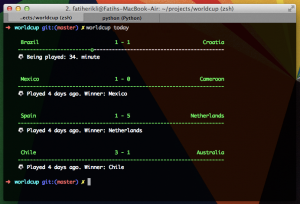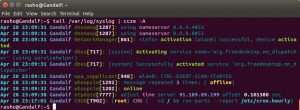Our very own Jackie Balzer (head of front-end development at Behance) has written Part 2 in her series, Sass for Big Sites. It is published in Web Standards Sherpa, is featured in CSS Weekly, and is being shared widely around the web. It is highly recommended if you are interested in CSS, Sass (or other CSS preprocessors) or simply managing a large scale codebase. Great work, Jackie!
How to Build a CentOS 7 AMI (Amazon Machine Image) From Scratch
Building an AMI (Amazon Machine Image) from scratch can be a pretty challenging task, especially when you don’t have a base AMI to work from. We’ve been testing CentOS 7 on VirtualBox, Rackspace, and on physical machines, but realized that Amazon did not have published CentOS 7 AMIs at that time. So we proceeded to build our own AMIs from scratch. It has taken many weeks of trial and error, diving into the Linux boot process, digging through documentation, fixing bugs in tools, porting over legacy grub. We’ve documented all of the steps below - hopefully you will find it helpful in creating your own AMIs.
Developer’s Tookit: Anshu Pande
This post is part of a series where Behance developers talk about the various tools they use to get things done and make ideas happen.
 1.) Who are you and what do you do at Behance?
1.) Who are you and what do you do at Behance?
I am Anshu Pande and I am a Security Operations Engineer with Adobe Behance. I work Closely with the Devs/Ops/QE/Asset teams as well as other internal and external Adobe teams keeping track of all the vulnerabilities that the Behance environment has or could be infected with. I am an Amazon AWS Certified Solutions Architect. I follow cloud best-standards to secure our cloud infrastructure. I believe that if we do our basics in a correct way from the start, we will make a very powerful end product that will be easy to use. I have deployed various tools to help detect problems, tools such as Evident IO, Netflix Security Monkey and AWS Trusted Advisor. I also hack/scan internal websites and infrastructure using tools like Qualys/ZAP and I am a certified White Belt and Green Belt security Ninja.
Navigating an AMD codebase in Sublime Text using Static Analysis and Node.js
As your JavaScript codebases grow, it can be difficult to stay productive within your editor. Whether you are looking for modules that require the current module or simply trying to hop between dependencies; most tasks related to navigating a large codebase require numerous steps that become tedious and can seriously hinder productivity.
Behance engineer, Joel Kemp, writes about how he used static analysis techniques via Esprima and Node.js to overcome these problems within Sublime Text 3. Check out the post: Navigating an AMD Codebase in Sublime Text.
Bēhance Dev Links Issue 01
World cup results for hackers. Uses Soccer For Good API
Nothing like getting sports scores and info in your Terminal!
submitted by Rachel White
JS NICE
“Statistical Renaming, Type Inference and Deobfuscation”
Nice!
submitted by Joe Sepi
Create a TV Show Tracker using AngularJS, Node.js and MongoDB
An introduction to full-stack javascript development that uses express on the backend, mongodb for data storage, and AngularJS on the client.
submitted by Sean Dunn
Colorize log files on CentOS and Ubuntu using ccze tool
Even though you might be using centralized logging tools like Splunk, Logstash, or Sumologic, occasionally you just want to go in and tail a log yourself. Ccze is an awesome, custom-color formatting tool that makes the arduous task of reading/searching through logs a little more pleasant.
submitted by Malcolm Jones Read more →
Developer’s Toolkit: Mike Sherov
This post is part of a series where Behance developers talk about the various tools they use to get things done and make ideas happen.
 1. Who are you, and what do you do at Behance?
1. Who are you, and what do you do at Behance?
I’m Mike (and that’s one of my twins, Grant, on my shoulders. Julian’s a bit shy!). I’m primarily a JS engineer, but I also dabble in PHP, Mustache, and SCSS. I guess you’d say I’m a full stack dev who just prefers writing JS. I have a strong passion for testing, deployment, and code quality. I maintain (and contribute to) Behance’s static analysis toolchain: SCSSLint, JSHint, JSCS, PHPCS, and am currently working on centralized logging using Sumologic.
Read more →
Developer’s Toolkit: Rachel White
This post is part of a series where Behance developers talk about the various tools they use to get things done and make ideas happen.
 1. Who are you and what do you do at Behance?
1. Who are you and what do you do at Behance?
I’m Rachel White, and I’m a Software Engineer. I’m on the JavaScript team and I mostly work on refactoring legacy code to be more up-to-date with new standards we’ve set for ourselves. Sometimes I work on CSS projects and prototyping new ideas for the site, too.
Developer’s Toolkit: Mark Dunphy
This post is part of a series where Behance developers talk about the various tools they use to get things done and make ideas happen.
 1. Who are you, and what do you do at Behance?
1. Who are you, and what do you do at Behance?
By now you’ve probably already learned my name, so I suppose I won’t go into that. However, I will tell you that I’m a backend software engineer at Behance. I have the interesting position of floating between teams and products quite frequently, so I get to leave a little Mark (hah, get it?) on everything. Beyond the sprinkling of love and code I put into other team members’ projects, I’m primarily responsible for Behance emails (notifications, automated digests, switching service providers, you name it) and fighting spam.
Developer’s Toolkit: Andrew Crerar
This post is part of a series where Behance developers talk about the various tools they use to get things done and make ideas happen.
 1. Who are you, and what do you do at Behance?
1. Who are you, and what do you do at Behance?
I’m Andrew and I’m responsible for the development and day-to-day operation of our Custom Creative Networks. What is a Custom Creative Network (CCN)? I’m glad you asked! CCN’s are essentially streamlined, thinner versions of Behance but differ in that they have the ability to be customized; really cool stuff. On a normal day you can catch me working the full stack: anything from writing SQL, PHP, or JS, to making CSS changes and going to production (Wooo)!
Read more →
Developer’s Toolkit: Nina Berg
This post is part of a series where Behance developers talk about the various tools they use to get things done and make ideas happen.
 1. Who are you and what do you do at Behance?
1. Who are you and what do you do at Behance?
Hey there, I’m Nina Berg, a Quality Engineer here at Behance. Our team’s job is to ensure Behance is as stable and bug-free as possible. To that end, we work on developing whatever tools, infrastructure, and processes are needed to test our website. My recent projects include working on a Selenium testing library called Paige, and designing a continuous integration workflow for the cookbooks our devops team works on.
Read more →


